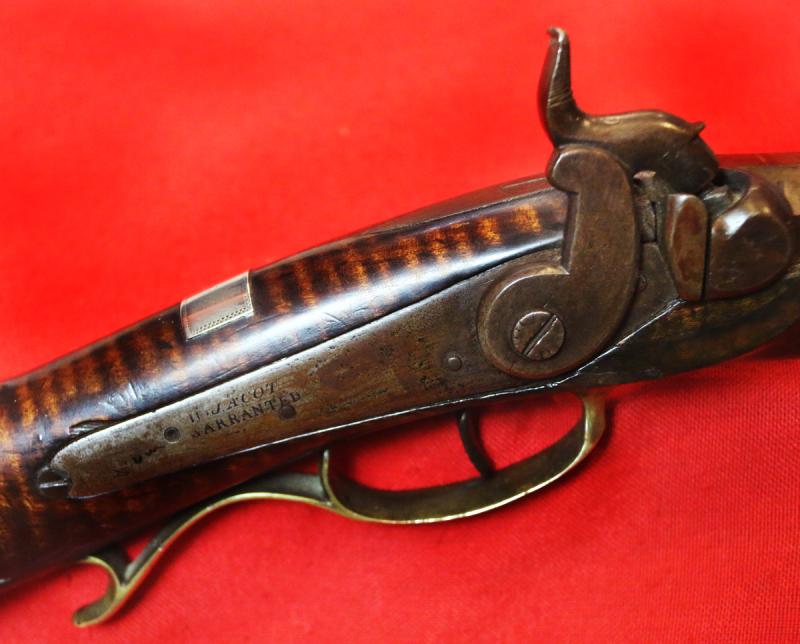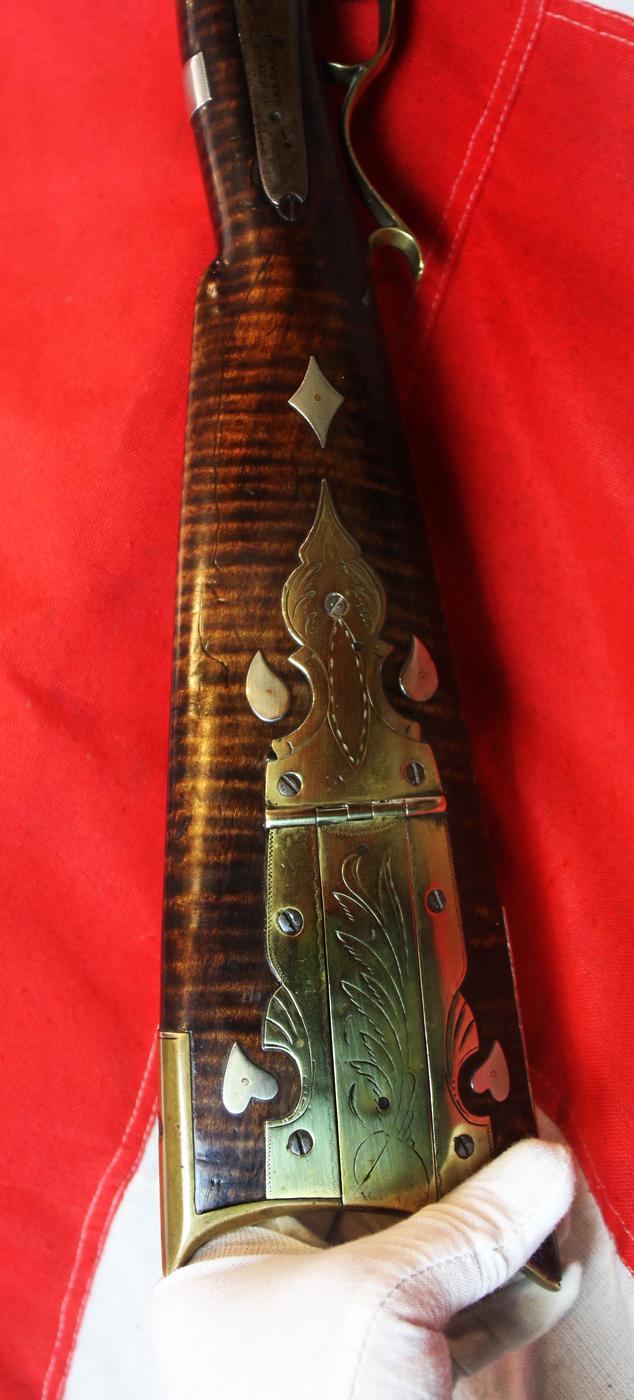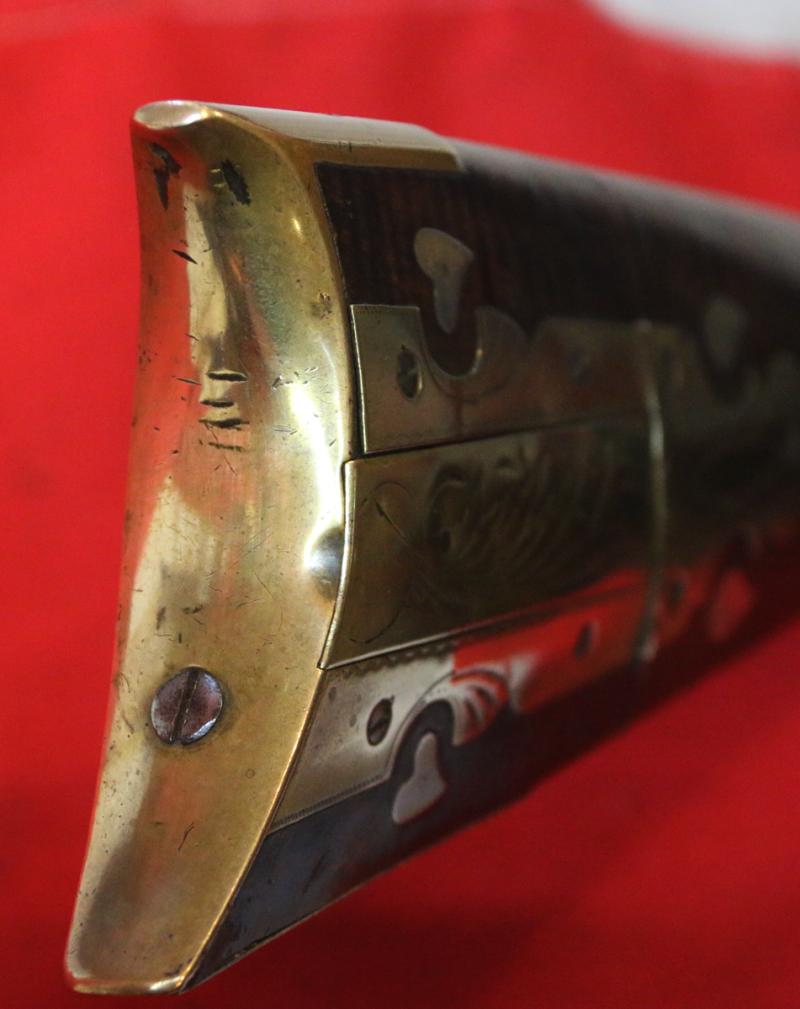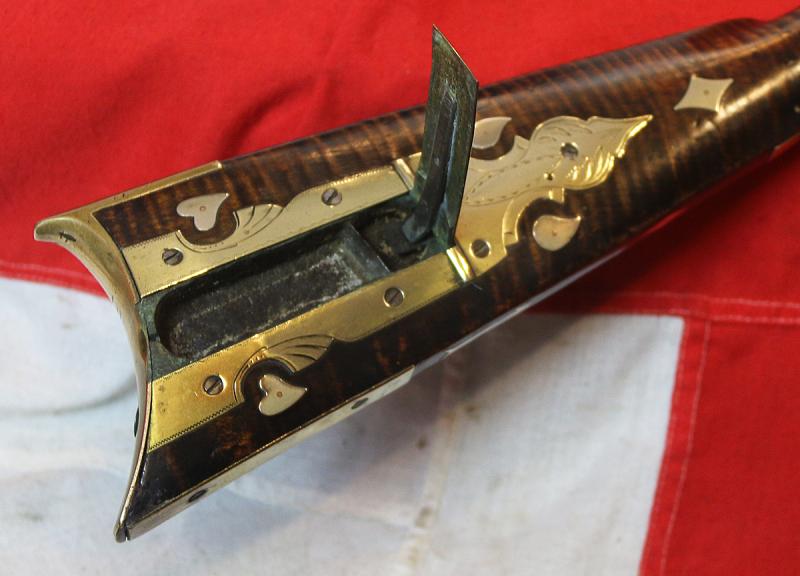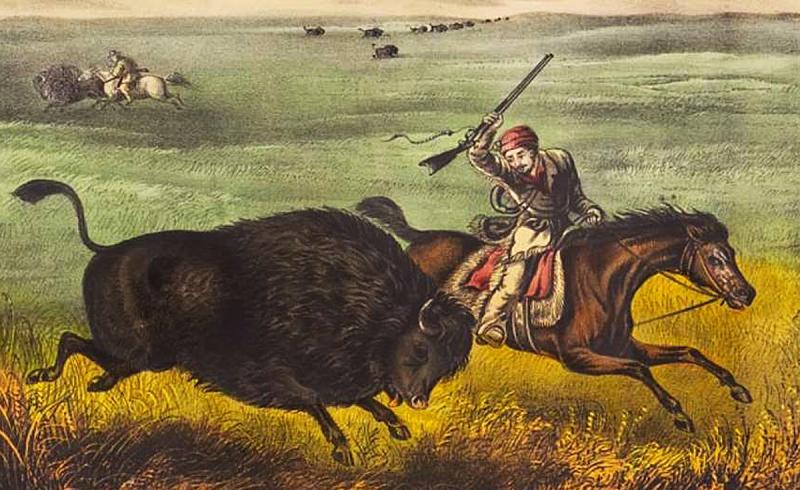SOLD Simply Beautiful American Frontiersman's Plains Gun, The So Called Kentucky or Pennsylvania "Hawken" Rifle. One Of The Most Attractive and Finest quality Examples We Have Seen In Years. Used By Some of The Most Hardy and Toughest Men Imaginable
One of the best examples that we have seen in decades, and, a museum quality piece, from the first quarter to mid 19th century. Effectively, like the finest Japanese samurai swords, worthy of the title of a 'work of art' that happens to also be a functional frontier plainsman's rifle. Finest quality walnut stock with excellent natural age patina. Octagonal, rifled .38 barrel, with rear site, front silver blade site, pale brass mounts, all fabulously engraved throughout, including trigger guard with hand grip, a stunning large engraved patch box, and deep crescent butt plate, and inlaid throughout with small German silver differing shaped plaques, and with a brass tipped wooden ramrod. Hook breech for ease and simplicity as a quick release for fast disassembly.
The "plains rifle" also known as a "Hawken rifle" was a shorter rifle more suitable for carrying on horseback. It was popular among mountain men and North American fur trappers in the 19th century. The Hawken brothers (Samuel and Jacob) were one of a number of famous gunsmiths active in St. Louis in the 1830s-1860s. Many renowned gunsmiths such as Horace (H.E.) Dimick and J. P. Gemmer produced powerful and portable "short" rifles for the Rocky Mountain fur trade, overland exploration, and the transcontinental immigrant trains. The plains rifle combined accuracy with portability in a more compact package than the extreme long guns from which it had evolved. While many plains rifles were built to fire heavy rounds against dangerous game, more were bored around the .40 calibre range for medium game hunting. Long rifles tended to be slimmer and more elegant than the later, more massive, and shorter-barreled Hawken variant rifles.
The Hawken rifle evolved from the long rifle for use against larger, more dangerous game, and for personal protection against unsavoury protagonists or hostiles, often encountered in the American West frontier. For firing heavier and larger diameter bullets and heavier powder loads, the barrel wall thickness was necessarily strengthened, and the barrel length of the Hawken was shortened to keep the carrying weight manageable. Finest 'Tiger stripe' pattern stock, probably maple wood, stock. The front sight is a blade sight. It was said that the old mountain men, trappers, fur traders, General William Ashley, the famous scout Kit Carson, pioneers of the 'Gold Rush' and the best buffalo hunters would have no other gun than a 'Hawken' style rifle. Almost any price in gold, furs or merchandise would be willingly paid to own one.
As defined by Hine and Faragher, "frontier history tells the story of the creation and defence of communities, the use of the land, the development of markets, and the formation of states." They explain, "It is a tale of conquest, but also one of survival, persistence, and the merging of peoples and cultures that gave birth and continuing life to America." Turner himself repeatedly emphasised how the availability of free land to start new farms attracted pioneering Americans: "The existence of an area of free land, its continuous recession, and the advance of American settlement westward, explain American development." Through treaties with foreign nations and native tribes, political compromise, military conquest, the establishment of law and order, the building of farms, ranches, and towns, the marking of trails and digging of mines, and the pulling in of great migrations of foreigners, the United States expanded from coast to coast, fulfilling the dreams of Manifest Destiny. Turner, in his "Frontier Thesis" (1893), theorised that the frontier was a process that transformed Europeans into a new people, the Americans, whose values focused on equality, democracy, and optimism, as well as individualism, self-reliance, and even violence.
As the American frontier passed into history, the myths of the West in fiction and film took a firm hold in the imaginations of Americans and foreigners alike. In David Murdoch's view, America is exceptional in choosing its iconic self-image: "No other nation has taken a time and place from its past and produced a construct of the imagination equal to America's creation of the West. The frontiersmen were a remarkable breed of men. They were often rough and illiterate, sometimes brutal and vicious, often seeking an escape in the wilderness of mid-America from crimes committed back east. In the beautiful but deadly country which would one day come to be known as West Virginia, Kentucky, Michigan, Ohio, Indiana, and Illinois, more often than not they left their bones to bleach beside forest paths or on the banks of the Ohio River, victims of Native American Indians who claimed the vast virgin territory and strove to turn back the growing tide of white settlers.
Against the background of such names as George Rogers Clark, Daniel Boone, Arthur St. Clair, Anthony Wayne, Simon Girty and William Henry Harrison, and one of America's most outstanding heroes, Simon Kenton. Kenton's role in opening the Northwest Territory to settlement more than rivaled that of his friend Daniel Boone. By his eighteenth birthday, Kenton had already won frontier renown as woodsman, fighter and scout. His incredible physical strength and endurance, his great dignity and innate kindness made him the ideal prototype of the frontier hero."
European exploration of the region dates to the 1600s. It was Pennsylvanian Simon Kenton who was the key to settling Limestone, the nearby town
of Washington, and the county. Another explorer of the area was Robert McAfee, who arrived in June 1773. John Hedges gave the site its original name of Limestone earlier in 1773. But it was Kenton, on his fourth visit in 1775, who found Limestone cove and the canebrakes three miles south of Limestone that became part of pioneer legend.
Here Kenton built his cabin and began promoting the area. The site of Limestone was locked between the river and hills with insufficient land for farming and vulnerable to Indian attacks. Most settlers moved to the hills above Limestone or migrated farther to the west.
In 1776 numerous exploring parties came to Limestone, and Kenton welcomed them and helped guide them to their destinations.
Local tradition holds that he urged only those visitors he found especially promising to stay in the area. Indian attacks kept most settlers away before 1784, the year Kenton returned to Limestone with 60 men. William Bickley, Edward Waller, and John Waller of that party built at the mouth of Limestone Creek a blockhouse that was the beginning of Maysville
Simon Kenton came west from Virginia when he thought he had killed a man. As an early Mason County settler, in 1784 he built Kenton’s Station to defend against Native American “War Parties.” Kenton took advantage of his role at the forefront of settlement by claiming huge amounts of land for himself through so-called “tomahawk improvements.” These he made by chopping his initials or “mark” into large trees at the four corners of the land he desired.
Using this early method to land claim, it is believed that Kenton once owned nearly half a million acres in what one day would become Kentucky, Ohio, Indiana, Illinois, and Missouri. By 1790, he also owned and resided on a comfortable estate in northern Kentucky, living in a large brick house with his wife, surrounded by his children, horses, and tenant farmers.
Arthur Wood established Washington on land he purchased from Simon Kenton.
In 1799, soon after his first wife died, Kenton looking for new ground, moved North. He initially settled near what became Springfield OH.
22 inch barrel. 37.5 inches overall. percussion back action lock made by W.Jacot, marked Warranted Excellent condition for age overall, great patina, and tight crisp action.
Code: 24794
Price
on
Request



